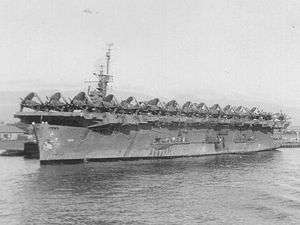USS Bougainville (CVE-100)
 | |
| History | |
|---|---|
| Name: | USS Bougainville |
| Namesake: | The Bougainville campaign of 1943-1945 |
| Builder: | Kaiser Shipyards |
| Launched: | 16 May 1944 |
| Commissioned: | 18 June 1944 |
| Decommissioned: | 3 November 1946 |
| Struck: | 1 May 1960 |
| Fate: | Sold for scrap on 29 August 1960 |
| General characteristics | |
| Class and type: | Casablanca-class escort carrier |
| Displacement: | 7,800 tons (light), 10,400 tons (full load) |
| Length: | 512 ft 3 in (156.13 m) overall |
| Beam: | 65 ft 2 in (19.86 m), 108 ft 1 in (32.94 m) maximum width |
| Draft: | 22 ft 6 in (6.86 m) |
| Propulsion: |
|
| Speed: | 19 knots (35 km/h) |
| Range: | 10,240 nmi (18,960 km) @ 15 kn (28 km/h) |
| Complement: |
|
| Armament: | 1 × 5 in (127 mm)/38 cal dual purpose gun, 16 × Bofors 40 mm guns (8×2), 20 × Oerlikon 20 mm cannons (20×1) |
| Aircraft carried: | 28 |
| Service record | |
| Part of: | United States Pacific Fleet (1944-1946), Pacific Reserve Fleet (1946-1960) |
| Operations: | Invasion of Iwo Jima, Battle of Okinawa |
| Awards: | 2 Battle stars |
USS Bougainville (CVE-100) was a Casablanca class escort carrier of the United States Navy, built and used during World War II. She was launched on May 16, 1944 by the Kaiser Shipyards in Vancouver, Washington, under a Maritime Commission contract; sponsored by Mrs. Sally A. Montfort, wife of Captain Montfort, acquired on June 18, 1944; and commissioned the same day, Captain C. A. Bond in command.
Service history
World War II
On July 25, 1944, Bougainville departed San Diego and steamed to Pearl Harbor where on 1 August she reported to Commander, Carrier Transport Squadron, Pacific Fleet. For the rest of 1944, she transported aircraft to the Marshall, Admiralty, and Mariana Islands. Returning to San Diego on 22 December, she underwent a brief period of availability until January 7, 1945.
On February 8, 1945, Bougainville reported to Commander, Service Squadron 8, at Eniwetok and for the next six months provided replenishment throughout the Western Pacific to the various Task Groups (TGs) of Task Forces 58 and 38 (TFs 58 and 38). She rendezvoused with these groups at sea, delivering planes, replacement pilots and aircraft crews to the large fleet carriers. In February–March 1945, she carried out replenishment operations with TG 60.8 during the Iwo Jima operation. Until June, she provided vital logistic support to the units of the 5th and 3rd Fleets as they engaged in raids supporting the Okinawa operation.
In August, after a brief period of availability at San Diego, Bougainville returned to Pearl Harbor. During the remainder of the month, she transported aircraft between Pearl Harbor and the Marshalls and Marianas.
Post war
In September, she steamed to Okinawa, where she remained until getting underway on 6 October 1945 to deliver planes and occupation personnel to several Chinese ports. Returning to Okinawa on the 19th, she departed the following day for San Diego. At San Diego, she underwent a brief yard period until November 28th, and then made her final voyage to Pearl Harbor and Eniwetok. She returned to San Diego on January 12, 1946 and reported to the 19th Fleet for inactivation. She sailed from San Diego on January 19th en route to Port Angeles Wash., and then to Tacoma. Bougainville was placed out of commission in reserve there on 3 November 1946. She was reclassified CVU-100 on June 16, 1955.
Bougainville was stricken and scrapped in 1960.
Awards
Bougainville received two battle stars for her World War II service.
References
This article incorporates text from the public domain Dictionary of American Naval Fighting Ships.